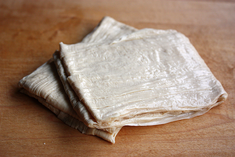
Back جلد التوفو Arabic Yuba Danish Yuba German Jubo Esperanto Yuba (alimento) Spanish Peau de tofu French יובה HE Kembang tahu ID Yuba (cibo) Italian ゆば Japanese
 | |
| Nutritional value per 100 g (3.5 oz) | |
|---|---|
| Energy | 2,217 kJ (530 kcal) |
7.2 g | |
| Dietary fiber | 3.0 g |
32.1 g | |
| Saturated | 4.98 g |
| Monounsaturated | 7.50 g |
| Polyunsaturated | 16.26 g |
50.4 g | |
| Vitamins | Quantity %DV† |
| Vitamin A equiv. | 0% 1 μg0% 7 μg |
| Thiamine (B1) | 29% 0.35 mg |
| Riboflavin (B2) | 9% 0.12 mg |
| Niacin (B3) | 9% 1.4 mg |
| Pantothenic acid (B5) | 11% 0.55 mg |
| Vitamin B6 | 19% 0.32 mg |
| Folate (B9) | 10% 38 μg |
| Vitamin E | 16% 2.4 mg |
| Vitamin K | 46% 55 μg |
| Minerals | Quantity %DV† |
| Calcium | 16% 210 mg |
| Copper | 363% 3.27 mg |
| Iron | 46% 8.3 mg |
| Magnesium | 52% 220 mg |
| Phosphorus | 48% 600 mg |
| Potassium | 28% 840 mg |
| Selenium | 13% 7 μg |
| Sodium | 1% 12 mg |
| Zinc | 45% 4.9 mg |
| Other constituents | Quantity |
| Water | 6.9 g |
| Water Soluble Dietary Fiber | 0.6 g |
| Insoluble Dietary Fiber | 2.4 g |
| Biotin(B7) | 37.3 µg |
Vitamin E showed only α-tocopherol
[1] | |
| †Percentages estimated using US recommendations for adults,[2] except for potassium, which is estimated based on expert recommendation from the National Academies.[3] | |
| Regional names | |||||||||||||
|---|---|---|---|---|---|---|---|---|---|---|---|---|---|
| Chinese name | |||||||||||||
| Chinese | 腐皮 | ||||||||||||
| Literal meaning | beancurd skin | ||||||||||||
| |||||||||||||
| Chinese name 2 | |||||||||||||
| Chinese | 豆腐皮 | ||||||||||||
| Literal meaning | tofu skin | ||||||||||||
| |||||||||||||
| Korean name | |||||||||||||
| Hangul | 두부껍질 | ||||||||||||
| Literal meaning | tofu skin | ||||||||||||
| |||||||||||||
| Japanese name | |||||||||||||
| Kanji | 湯葉 | ||||||||||||
| Kana | ゆば | ||||||||||||
| |||||||||||||
Tofu skin, yuba, beancurd skin, beancurd sheet, or beancurd robes is a food item made from soybeans. During the boiling of soy milk, in an open shallow pan, a film or skin composed primarily of a soy protein-lipid complex forms on the liquid surface.[4][5] The films are collected and dried into yellowish sheets known as tofu skin.[6][7] Since tofu skin is not produced using a coagulant, it is not technically a proper tofu; however, it does have a similar texture and flavor to some tofu products.
Tofu skin's use was first documented in written records in China in the sixteenth century. It is widely used, fresh, fermented, or dried, in Chinese, Korean, and Japanese cuisine.
- ^ Ministry of Health, Labour and Welfare Japanese Dietary Intake Standards (2015 Edition)
- ^ United States Food and Drug Administration (2024). "Daily Value on the Nutrition and Supplement Facts Labels". FDA. Archived from the original on 27 March 2024. Retrieved 28 March 2024.
- ^ National Academies of Sciences, Engineering, and Medicine; Health and Medicine Division; Food and Nutrition Board; Committee to Review the Dietary Reference Intakes for Sodium and Potassium (2019). Oria, Maria; Harrison, Meghan; Stallings, Virginia A. (eds.). Dietary Reference Intakes for Sodium and Potassium. The National Academies Collection: Reports funded by National Institutes of Health. Washington, DC: National Academies Press (US). ISBN 978-0-309-48834-1. PMID 30844154. Archived from the original on 9 May 2024. Retrieved 21 June 2024.
- ^ Shurtleff, William; Aoyagi, Akiko (2004). "History of Yuba". History of Soybeans and Soyfoods: 1100 B.C. to the 1980s. Soyinfo Center. Retrieved 18 February 2021.
- ^ BEAN SKIN (腐竹) ; A PRODUCT OF BLOOD & SWEAT FROM THE MAKERS. Journal of the Hong Kong Branch of the Royal Asiatic Society. Vol. 17. 1977.
- ^ Shurtleff, William; Aoyagi, Akiko (2012). History of Yuba – The Film That Forms atop Heated Soymilk (1587–2012). Lafayette, California: Soyinfo Center.
- ^ Shurtleff, William; Aoyagi, Akiko (1983). The Book of Tofu. Berkeley, California: Ten Speed Press.
© MMXXIII Rich X Search. We shall prevail. All rights reserved. Rich X Search